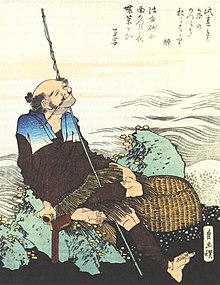Surimono


Surimono (摺物) are a genre of Japanese woodblock print. They were privately commissioned for special occasions such as the New Year. Surimono literally means "printed thing". Being produced in small numbers for a mostly educated audience of literati, surimono were often more experimental in subject matter and treatment, and extravagant in printing technique, than commercial prints. They were most popular from the 1790s to the 1830s, and many leading artists produced them.[1] One of the most famous woodblock artists who got his start from producing surimono was Suzuki Harunobu, credited with being the genius behind the later introduction (in the 1760s) of Nishiki-e ("brocade prints").
Use
[edit]In most cases, surimono were commissioned by poetry societies to illustrate the winning poem in a poetry contest judged by the master of the society. Such prints generally had a small format, often c. 205 × 185 mm, and the relief carving of the Kanji characters took a great deal of technical skill. Kabuki actors also commissioned surimono prints to commemorate important events in their careers, such as changes of name and stage debuts of their sons.
See also
[edit]- Ukiyo-e
- Woodblock printing
- Woodcut
- Frank Lloyd Wright was a collector of surimono
References
[edit]- ^ "surimono". Japanese Architecture and Art Net Users System. Retrieved 2009-12-30.
- Hockley, Allen (2006). Public Spectacles, Personal Pleasures: Four Centuries of Japanese prints from a Cincinnati Collection. Cincinnati: Cincinnati Art Museum. ISBN 0-931537-29-0.
Further reading
[edit]- Bowie, Theodore; in collaboration with James T. Kenney and Fumikoe Togashi (1981). Art of the Surimono. N/A: Indiana University Press. ISBN 9780253304759. OCLC 795508326. Based on an exhibition at the Indiana University Art Museum, February 25 – March 25, 1979.
{{cite book}}: CS1 maint: postscript (link)
External links
[edit]- Surimono on the website of the Art, Design & Architecture Museum

